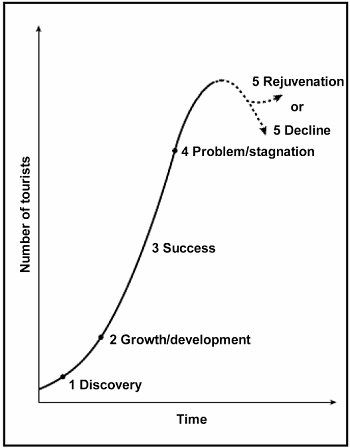By Peter Huston
 It’s September and the number of golf carts going by is already waning. 5 months, tops is all we have to make a living here in Put-in-Bay. The laughter and good times go by our window hourly all summer. This summer the number of laughing visitor “woowoos “ has been way up.
It’s September and the number of golf carts going by is already waning. 5 months, tops is all we have to make a living here in Put-in-Bay. The laughter and good times go by our window hourly all summer. This summer the number of laughing visitor “woowoos “ has been way up.
It’s not a scientific measure of fun, but it seems to be a great barometer for the enjoyment index which appears to be up. Certainly golf carts are the most desirable mode of transportation while here and there must be something that brings out the child like emotional responses that turns into ‘woowoo”. I love the joy that this represents as visitors enjoy their time here.
Resort cycle economics as geographers (http://geographyfieldwork.com/ButlerModel.htm) call it, is a concept that defines our island economy. This year’s many many sunny weekends allowed us to achieve a high level of “woowoo” success. The Butler Model for tourism charts the rise of a destination based on the increase in number of tourists over time.
There are 5 steps in this cycle: Discovery, growth and development, success, stagnation/problems rejuvenation or failure. According to the Barcelona Field Studies Centre this cycle can repeat many times over the history of a resort or just once and end with complete failure. Places like Euclid Beach, Geneva By the Lake, Ocean City (NJ), and Nantasket Beach (MA) are examples of resorts that peaked in a different social and technological era.
A case can be made that Put-in-Bay has survived at least two of these cycles as we head into the success phase of the third cycle. I think the 1870’s represented the start of the first cycle. The increase in grape growing brought more people here to experience the wine and the island experience. That growth and success peaked just before prohibition. The Volstead Act caused a severe downturn in the economy that did not rebound until the 1960’s.
During the 60’s an “organic’ rejuvenation began to take place. Land was very cheap and families and fisherman started to buy up cottages and land. Slowly the growth of this “poor mans” Nantucket created interest in a second wave of summer tourism. This successful rediscovery of the islands led to the peak of the lassies faire 70’s that saw Put-in-Bay grow into a hip albeit low key summer hangout.
At any point in this process Put-in-Bay could have failed and other destinations might have successfully prospered. Places like Euclid Beach, Geneva on the Lake just did not have the elements needed to spur rejuvenation during this era and today they are B&W photo memories of their heyday.
It could be argued that the two things that changed the growth and success of Put-in-Bay included the high speed late night ferry and golf carts. The overall expansion of ferry service allowed for sustainable growth of businesses and support services. The introduction of the golf cart provided an economical transportation investment alternative and affordable way to see the island in a casual manor.
Today, as thousands of visitors go by on a cart enjoying the island experience, we seem to be approaching another peak in the resort cycle. There is a limit to how many people on a busy day can experience that euphoric “woohoo’ day. Not enough golf carts, parking spots and short term lodging places to support the maximum capacity on peak days and not enough people coming on the off peak days to sustain the investment to finance that growth.
In essence we are experiencing great success which is bringing more people here now than ever before and we need to figure out how to be able to scale up the services, shopping and lodging on these peak days without over investing. As we get to the next level in the resort cycle we need to keep those euphoric “woowoos” loud and plentiful. It’s key to the islands continued success.